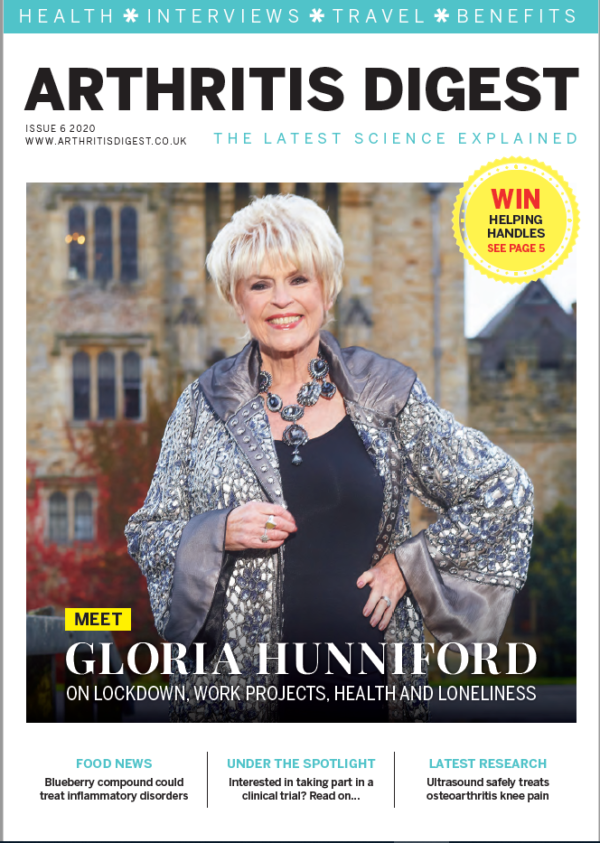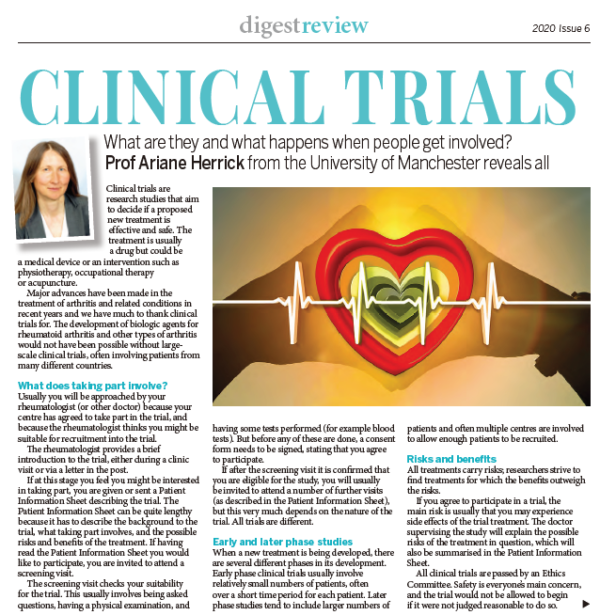A guide to clinical trials – Professor Ariane Herrick speaks to Arthritis Digest
Arthritis Digest is a magazine for people with arthritis that highlights the latest relevant research and reviews topical issues. Throughout 2020, researchers from Manchester BRC’s Musculoskeletal theme have contributed regular articles, with this latest one from Ariane Herrick, Professor of Rheumatology, giving an overview on how clinical trials work.
Clinical Trials – What are they and what happens when people get involved? Prof Ariane Herrick from the NIHR Manchester BRC reveals all.
Clinical trials are research studies that aim to decide if a proposed new treatment is effective and safe. The treatment is usually a drug but could be a medical device or an intervention such as physiotherapy, occupational therapy or acupuncture.
Major advances have been made in the treatment of arthritis and related conditions in recent years and we have much to thank clinical trials for. The development of biologic agents for rheumatoid arthritis and other types of arthritis would not have been possible without largescale clinical trials, often involving patients from many different countries.

What does taking part involve?
Usually you will be approached by your rheumatologist (or other doctor) because your centre has agreed to take part in the trial, and because the rheumatologist thinks you might be suitable for recruitment into the trial.
The rheumatologist provides a brief introduction to the trial, either during a clinic visit or via a letter in the post.
If at this stage you feel you might be interested in taking part, you are given or sent a Patient Information Sheet describing the trial. The Patient Information Sheet can be quite lengthy because it has to describe the background to the trial, what taking part involves, and the possible risks and benefits of the treatment. If having read the Patient Information Sheet you would like to participate, you are invited to attend a screening visit.
The screening visit checks your suitability for the trial. This usually involves being asked questions, having a physical examination, and having some tests performed (for example blood tests). But before any of these are done, a consent form needs to be signed, stating that you agree to participate.

If after the screening visit it is confirmed that you are eligible for the study, you will usually be invited to attend a number of further visits (as described in the Patient Information Sheet), but this very much depends on the nature of the trial. All trials are different.
Early and later phase studies
When a new treatment is being developed, there are several different phases in its development. Early phase clinical trials usually involve relatively small numbers of patients, often over a short time period for each patient. Later phase studies tend to include larger numbers of patients and often multiple centres are involved to allow enough patients to be recruited.
Risks and benefits
All treatments carry risks; researchers strive to find treatments for which the benefits outweigh the risks. If you agree to participate in a trial, the main risk is usually that you may experience side effects of the trial treatment. The doctor supervising the study will explain the possible risks of the treatment in question, which will also be summarised in the Patient Information Sheet.
All clinical trials go through appropriate regulatory approvals, including review by a Research Ethics Committee (REC). Safety is everyone’s main concern, and the trial would not be allowed to begin if it were not judged reasonable to do so.
During participation you will be very closely monitored and asked to report any new symptoms in case these represent a side effect of treatment.
There may well be no direct benefit to you of taking part in the trial, although it is of course possible that the trial treatment under investigation will be helpful. However, you are helping others by allowing doctors and scientists to explore new treatments, which may prove to be effective and safe. Many patients find the close monitoring, which is part of every clinical trial, reassuring.
True Story: Kat Dunnicliff
“I was diagnosed with diffuse systemic sclerosis in December 2017 and began to attend Salford Royal Hospital. Whilst currently there is no cure for diffuse systemic sclerosis, myself and my family have welcomed the opportunity for me to be involved in research into treatment where I can.
“In January 2019 I began to participate in the Prednisolone in Early Diffuse Systemic Sclerosis (PRedSS) clinical trial. It was a six-month trial that involved an initial review, taking medicine, monthly blood tests, completing a diary and attending four review sessions over the period. The process was built into my normal consultation appointments and was extremely easy for me.
“The trial enabled me to contribute to research for others and explore a potential treatment for myself, which has enabled me to feel better and control my symptoms.”
How long do clinical trials take?
From the perspective of duration of patient participation, this can be very short (especially in early phase trials). Later phase studies can involve treatment periods of months or even longer. A key point is that anyone participating in a clinical trial may withdraw from the trial at any point, without giving a reason. Participation is always completely voluntary.
The bottom line
Clinical trials allow effectiveness and safety of new treatments to be determined. If you are given the opportunity to participate, discuss what the clinical trial involves (including possible risks and benefits) with your doctor and family. Should you decide to get involved, you will be closely monitored throughout the process. And you will know that by participating, you are ultimately helping the journey of discovering safe and effective new treatments.
I undertook the trial as I believe that those of us with rare diseases need to assist medical science, and to help develop new treatments.
True Story: Yvonne McKenna
“I was recently invited by my consultant to participate in a clinical trial to assess a drug that might help with my Raynaud’s phenomenon.
“Raynaud’s phenomenon occurs when the small blood vessels in the fingers, toes and other outer extremities are over-sensitive and constrict more in cold weather, turning white to blue and then red. Sometimes scleroderma (an autoimmune disease of connective tissue) causes the blood vessels to overreact, leading to Raynaud’s symptoms.
“My rheumatology consultant discussed the trial with me, explaining that I would have the active drug or a placebo and would need to attend the research unit on four separate occasions, spanning four weeks. No pressure was put on me. I was given an information sheet to read and time to make a decision.
“The first visit was essentially to check that I was suitable to take part in the trial. I met the research nurse and the research doctor in charge of the trial. My BMI was checked, urine and blood samples taken, and an electrocardiogram (ECG) and a full physical examination were undertaken. The second visit was quite lengthy, taking four or five hours. I was not allowed to eat or drink anything other than water that morning, until they finished with that day’s trial.
“A Venflon was sited in my arm so that blood samples could be taken throughout the day. A portable ECG was attached so my heart could be monitored. My fingers were analysed using a special camera that was able to see the tiny blood capillaries near the nails, and to measure the blood flow. My fingers were assessed before taking the drug or the placebo and again afterwards.
“Day three followed the same pattern. Day four was a comparatively quick check to make sure that I still felt ok and hadn’t had any obvious side effects.
“I undertook the trial as I believe that those of us with rare diseases need to assist medical science, and to help develop new treatments.”
Jargon
- Randomised controlled trial: Patients are allocated to different treatments in a random manner. Randomising people means the groups of patients allocated to the different treatments are likely to be very similar, so their results can be meaningfully compared.
- Double-blind: Neither the patient nor the doctor knows which treatment the patient is on, so the risk of results being biased is reduced.
- Placebo-controlled: The treatment being studied is compared to a placebo (dummy) treatment, which allows the effects of treatment to be compared to the effects of no treatment.
- Open-label: Patients and their doctor know what treatment they are on.
- Cross-over: Patients receive different treatments (such as active and placebo) at different time-points in the trial.
- Parallel group: Patients receive only one of the treatments being investigated, and results from them are compared to results from patients receiving the other treatment(s).